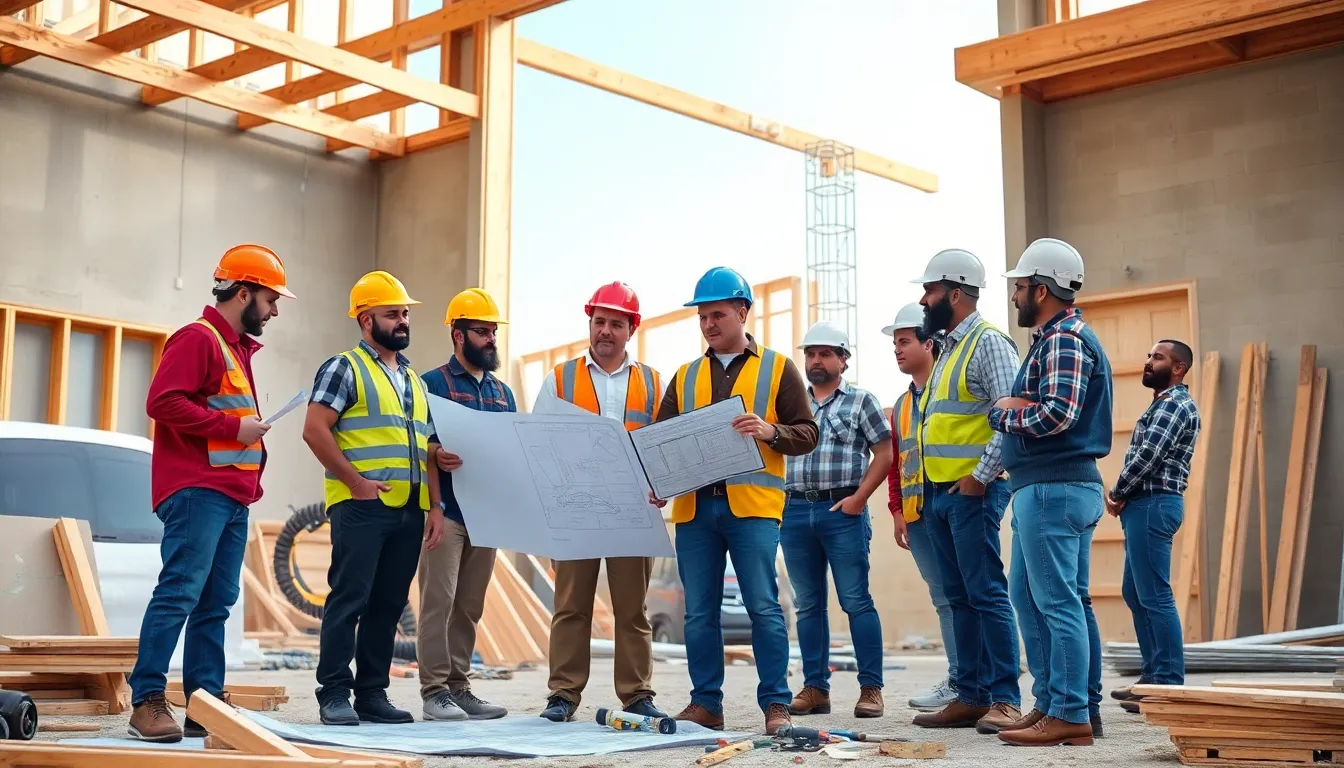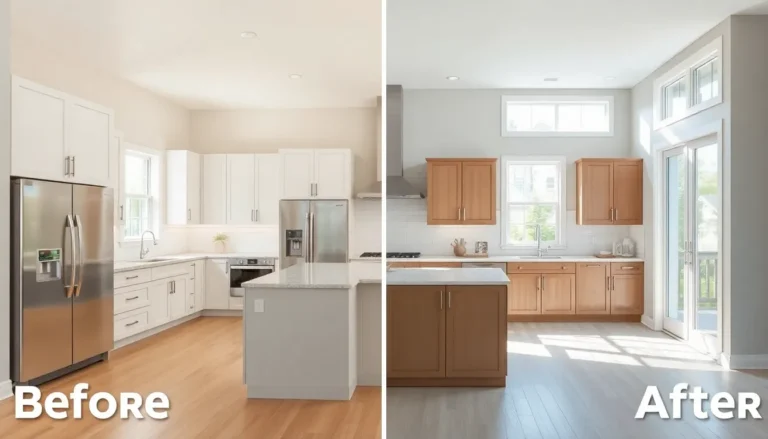Table of Contents
ToggleThinking about a building remodel? It’s like giving your space a much-needed makeover—think of it as a spa day for your home or office. Whether it’s updating that outdated kitchen or transforming a dull office into a vibrant workspace, a remodel can breathe new life into any environment.
Understanding Building Remodel
Building remodel refers to the process of renovating or updating a structure to enhance its functionality and aesthetics. This can involve various changes, from minor adjustments to extensive renovations.
Definition of Building Remodel
Building remodel encompasses a range of activities aimed at improving an existing building’s design and layout. Alterations may include updating finishes, changing room configurations, or enhancing energy efficiency. Remodeling often focuses on areas like kitchens or bathrooms, where functionality plays a significant role. Unlike new construction, remodeling utilizes existing structures while transforming them to meet current needs.
Importance of Building Remodel
Building remodel holds significant importance for both residential and commercial properties. Increased property value commonly results from well-executed renovations. An updated kitchen can enhance the overall appeal of a home, attracting potential buyers. Renovating office spaces improves employee productivity by creating an inviting atmosphere. Efficiency becomes a priority as modern upgrades reduce energy consumption and lower utility costs. Overall, remodeling serves to create spaces that better align with contemporary lifestyles and standards.
Planning Your Building Remodel

Planning a building remodel involves careful consideration of various aspects. Focusing on budget and timeline sets a solid foundation for the renovation process.
Setting a Budget
Determining the budget is crucial for any remodel project. Specific figures help guide decisions on materials and labor. Experts suggest allocating 10% to 15% of the total budget for unforeseen expenses. Contractors often provide estimates based on project scope. Prioritizing renovations based on importance and necessity ensures efficient use of resources. Researching costs for materials and services in advance can prevent overspending. Tracking expenses regularly throughout the project maintains control over the budget.
Creating a Timeline
Establishing a timeline is essential for managing the remodel. Identify key milestones to keep the project on schedule. Experts recommend breaking the remodel into phases for easier management. Each phase can include design, permits, construction, and final inspections. Consider factors such as contractor availability and material delivery times when creating the schedule. Setting a reasonable deadline helps avoid unnecessary delays. Regularly updating the timeline based on progress ensures accountability and keeps the project moving forward.
Key Factors to Consider
Several key factors influence the success of a building remodel. Understanding these factors helps homeowners and businesses create effective plans.
Structural Limitations
Structural limitations play a crucial role in remodeling. Assessing the foundation, walls, and roof is essential before making changes. Experts often recommend hiring a professional to evaluate load-bearing walls and provide insight on necessary reinforcements. Structural restrictions can dictate the scope of renovations, often impacting the layout and usable space. Outcomes from neglecting these limitations could include safety hazards or additional costs. Checking local building codes ensures compliance, preventing potential legal issues down the line.
Design and Aesthetics
Design and aesthetics greatly affect the overall success of a remodel. Selecting styles that reflect personal taste while enhancing functionality is vital. Considering the building’s purpose helps guide aesthetic choices. Combining modern trends with timeless elements often leads to pleasing environments. Incorporating natural light and open layouts can improve both atmosphere and energy efficiency. Balancing aesthetics with practical solutions creates spaces that are not only beautiful but also comfortable and usable. Seeking feedback from professionals can provide fresh perspectives on design choices, ensuring an inspiring outcome.
Hiring Professionals
Engaging professionals ensures a successful remodeling project, offering expertise that reduces stress and enhances outcomes. Skilled contractors and architects provide valuable insights for effective renovations.
Choosing the Right Contractor
Selecting the right contractor significantly influences the overall project. Researching credentials and past work enables informed decisions. Verifying licenses and insurance protects against potential liabilities. Professionals with strong local reputations often provide quality assurance. Meeting potential contractors in person allows for understanding their communication styles and approaches. Comparing multiple bids helps identify fair pricing. Prioritizing those with experience in specific remodeling tasks increases the likelihood of a successful outcome.
Benefits of Working with An Architect
Collaborating with an architect brings multiple advantages to the remodeling process. Architects offer tailored designs that align with clients’ visions while maximizing functionality. Their expertise in space planning can lead to innovative layouts and enhanced aesthetics. Compliance with local building codes is easier, ensuring safety and legality. Architects also assist in project management, streamlining communication among contractors and clients. Utilizing an architect’s network often leads to trusted subcontractors and suppliers. Ultimately, working with an architect elevates the quality of the remodel and helps create spaces that reflect individual styles.
Materials and Sustainability
Building remodels increasingly emphasize sustainability through material selection and design choices. Eco-friendly materials contribute to healthier living environments and reduce environmental impact.
Selecting Eco-Friendly Options
Recycled materials remain popular among homeowners seeking sustainable options. Bamboo flooring provides durability and rapid regrowth, making it a favorable choice. Low-VOC paints and finishes improve indoor air quality while minimizing harmful emissions. Choosing reclaimed wood not only adds character but also reduces wastage. Concrete alternatives, such as rammed earth or recycled aggregates, promote energy efficiency and longevity. Prioritizing certified green materials supports sustainable harvesting and production processes.
Cost-Effective Material Choices
Affordable materials don’t compromise quality or sustainability. Laminate surfaces mimic natural wood without the high costs, making them an attractive option. Recycled tiles offer a unique aesthetic and can be budget-friendly. Engineered wood products provide similar appearances to solid wood but at a lower price point. Insulation options, like cellulose made from recycled paper, enhance energy efficiency and reduce utility bills. Using local materials reduces transportation costs and supports community economies. Selecting cost-effective materials contributes to a well-planned, budget-friendly remodel without sacrificing environmental goals.
Building remodels offer an opportunity to transform spaces into functional and aesthetically pleasing environments. With careful planning and the right professionals, homeowners and businesses can achieve remarkable results that enhance both value and livability. Embracing sustainability through thoughtful material choices not only benefits the environment but also creates healthier spaces. As trends evolve and lifestyles change, investing in a remodel can ensure that a property remains relevant and inviting. Whether it’s a minor update or a major overhaul, the impact of a well-executed remodel is undeniable, making it a worthwhile endeavor for any property owner.





